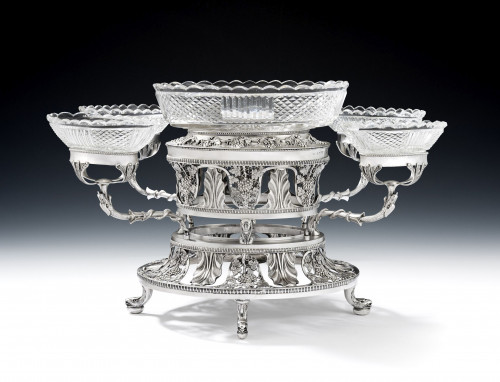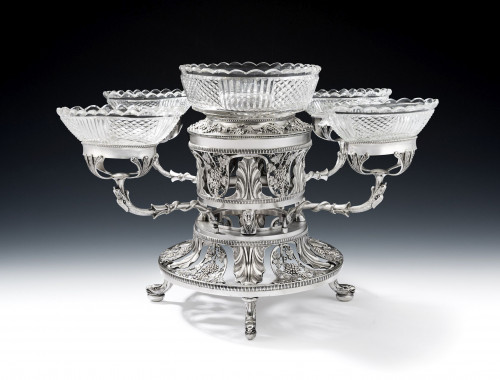- Home
- British Silver 1760-1830
- ROYAL. An important pair of George III Cast silver gilt figurative candlesticks both made in London, one in 1798 by Pitts & Preedy and the other in 1802 by Joseph Preedy.
ROYAL. An important pair of George III Cast silver gilt figurative candlesticks both made in London, one in 1798 by Pitts & Preedy and the other in 1802 by Joseph Preedy.
ROYAL. An important pair of George III Cast silver gilt figurative candlesticks both made in London, one in 1798 by Pitts & Preedy and the other in 1802 by Joseph Preedy.
374976
These exceptionally rare George III figurative Classical sculptures, holding aloft torches with candle sockets attached, were both made in London, one in 1798 by Pitts & Preedy and the other in 1802 by Jospeh Preedy. The difference in date is simply where the set was extended at a later date and the former partnership had ceased. Both are of a tall form and have great presence on the table. They are cast and stand on circular bases decorated with a band of laurel leaves and berries, rising to a Classically flat fluted band. The design of the figurative section is taken from ancient Greece and depicts two draped female figures of nobility, finely detailed in their casting, with material folds, belts, their hair being beautifully arranged. Both hold aloft a conical torch, decorated with three detailed bands of acanthus leaves. Each has a detachable beaded drip pan. The design and production of each piece is exceptional, as would be expected from this commission.
The bases are engraved with the contemporary script initials CPW for H.R.H. Caroline, Princes of Wales, below the Coronet of a Princess of Wales. She was to ascend as Queen Consort of King George IV, after the death of King George III in 1820. They are also engraved with the contemporary inital "M" below the Coronet of a Princess of the Blood Royal. These are as used by Princess Mary, Duchess of Gloucester and Edinburgh, eleventh child and fourth daughter of King George III and Queen Charlotte.
Silver bearing the cipher and coronet of Princess Caroline is extremely rare. She was the estranged wife of King George IV and was Princess of Wales from 1795 to 1820. She married her first cousin, George, Prince of Wales, at St. James's Palace on 8th April, 1795. They separated shortly after the birth of their daughter Princess Charlotte in 1796. In 1814 she moved to Italy and her silver, at this point, would have been returned to the Jewel House, this is why Princess Mary's cipher is also seen on the base, as the Jewel House would have re-allocated them to her. Caroline was devastated by the death of her daughter Princess Charlotte in childbirth in 1817, the news of which she heard from a passing courier, as George had refused to tell her. She was adored by the British public and when George III died in 1820, she became Queen of Great Britain and Ireland and Queen of Hanover. The King barred Queen Caroline from Westminster Abbey on Coronation Day in June 1821. The indignity of this event caused her great distress and she died three weeks later. Princess Mary died at Gloucester House in Weymouth in April 1857 and she was the longest lived and last survivor of George III's fifteen children. In the Will of Princess Mary, (proved 5th June, 1857, National Archives, PROB 11/2253) these pieces are described as "a pair of gilt Candlesticks standing in my own room under glass, at Gloucester House.
Both pieces are in excellent condition and, as we have intimated, make quite some statement on the table. The first portrait shown is of Queen Caroline painted in 1820 by James Lonsdale and the second is of Princess Mary, painted by Sir Thomas Lawrence in 1824.
Height: 15.6 inches, 39cm.
Diameter of the base: 5.1 inches, 12.75 cm.
Weight: 81oz, the pair.
Thank you for your enquiry.
We will get back to you soon.
Please create wishlist to add this item to
RELATED ITEMS

































